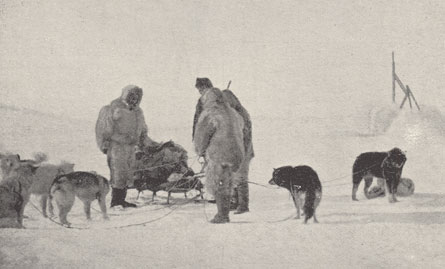The White March- Crevasse: A Deadly Hazard

A large crevasse in the ice can prove very
dangerous
A crevasse is a large, deep crack that scars the surface of a glacier or ice sheet. Crevasses form when the body of ice moves over uneven terrain. The ice in the middle edges moves at a slower pace than the ice on the outside edge. Because of this difference in movement the inside ice is compressed and the outside ice is pulled apart. These movements form deep gaps in the ice called crevasses. Crevasses are very dangerous as people, animals, and even whole sledge teams can fall into them. In all likelihood, the disappearances of two of Peary's team members, John Verhoeff and Ross Marvin, resulted from crevasses.
“We had advanced but eight miles, when we found ourselves hemmed in by a series of huge, concentric crevasses… Once we had two of our dogs down in a crevasse, and once a sledge, with all our biscuits and one hundred pounds of pemmican, broke through, and but for a projecting ledge of ice on the edge of the crevasse, which temporarily supported it till Astrup and myself could pull it out of danger, we should have lost all.” -Robert E. Peary in Northward over the “Great Ice”, published in 1898
"Crevasse of the 'Great Ice'" 1891 National Archives
